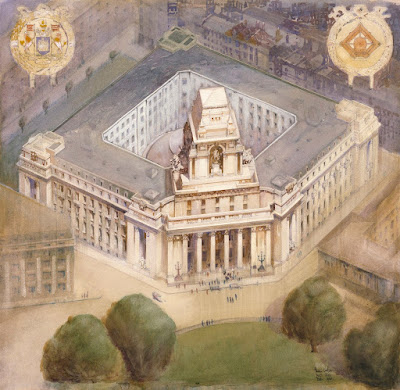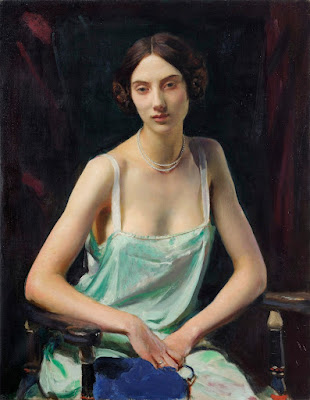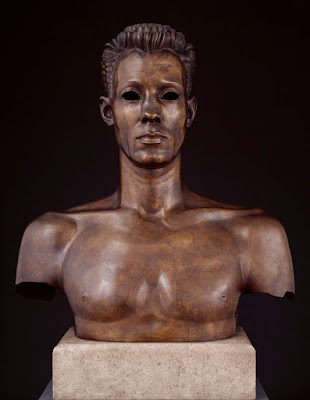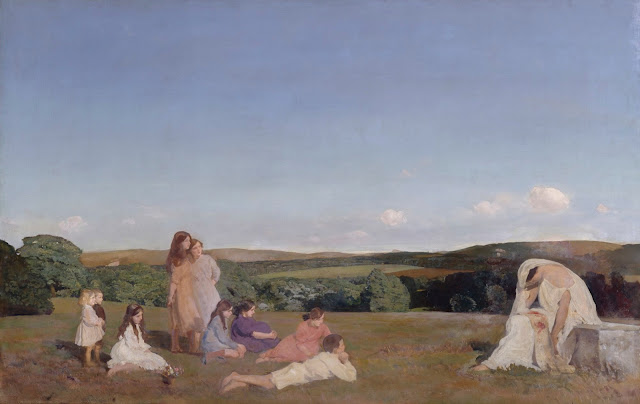 |
| Charles Cundall Demolition of Waterloo Bridge 1935 oil on board (diploma work) Royal Academy of Arts, London |
 |
| Simon Elwes Portrait of Sir Richard Sykes, 7th Baronet of Sledmere 1936 oil on canvas (diploma work) Royal Academy of Arts, London |
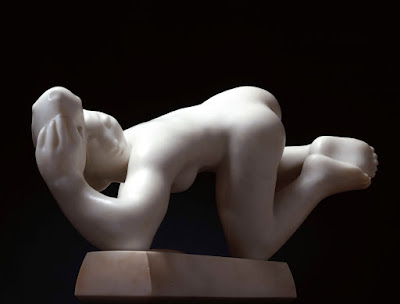 |
| Maurice Lambert Carving in Paros Marble ca. 1937 marble (diploma work) Royal Academy of Arts, London |
"Many of Lambert's sculptures show creatures in motion, reflecting his interest in mythology and metamorphosis. Here, the seemingly weightless woman is grasping a fish while swimming underwater. In her monograph on the artist, Vanessa Nicholson describes the work, writing "despite the 'primitive' elements evident in the features and the heavy treatment of the hands and feet, this female nude is imbued with a classicism one step removed from modern sculpture practice of the 1930s, dominated as it was by predominantly formal concerns."
 |
| Alfred Kingsley Lawrence Persephone 1938 oil on panel (diploma work) Royal Academy of Arts, London |
 |
| Reginald Eves Portrait of Sir Joseph Barcroft 1938 oil on canvas (diploma work) Royal Academy of Arts, London |
 |
| Herbert James Gunn Pauline Waiting 1939 oil on canvas (diploma work) Royal Academy of Arts, London |
"James Gunn studied at the Glasgow School of Art and Edinburgh College of Art before moving to Paris in 1911, where he entered the Académie Julian. By 1929 he had established himself as a portrait painter in London and worked very successfully in this field, receiving commissions from prime ministers, leading literary figures and royalty. Gunn married his second wife Pauline in 1929. The setting for her portrait is the lobby of Claridge's."
 |
| Stanley Anderson The Wheelwright 1939 engraving (diploma work) Royal Academy of Arts, London |
 |
| James Bateman Lullington Church 1939 oil on canvas (diploma work) Royal Academy of Arts, London |
"The 12th-century church at Lullington, a tiny hamlet situated in East Sussex on the South Downs, claims to be the smallest church in England. It measures a mere five by five metres. Technically, it is not a church at all but the chancel of an all-but destroyed larger church that once stood on the site."
 |
| E. Vincent Harris Design for Nottinghamshire County Hall, Nottingham 1940 drawing (diploma work) Royal Academy of Arts, London |
 |
| Dod Procter The Pearl Necklace completed ca. 1941 oil on canvas (diploma work) Royal Academy of Arts, London |
"The model in this painting features in several of Procter's work from around this time, a pattern that reflects the artist's preference to work repeatedly with models she befriended in her local area of Newlyn, Cornwall. The style of this portrait, painted over several years, is markedly different than Procter's paintings of the 1920s. Moving away from the solid sculptural forms of her earlier style, The Pearl Necklace is more impressionistic, with softer tonal variation. Procter had studied at the Atelier Colarossi in Paris during 1910-11, where Impressionist and Post-Impressionist influences were dominant."
 |
| Thomas Cantrell Dugdale Portrait of Sir Walter Lamb ca. 1943 oil on canvas (diploma work) Royal Academy of Arts, London |
 |
| Albert Richardson Design for reconstruction of the Physics Building, University College London 1944 drawing (diploma work) Royal Academy of Arts, London |
 |
| George Belcher Self Portrait 1944 oil on canvas (diploma work) Royal Academy of Arts, London |
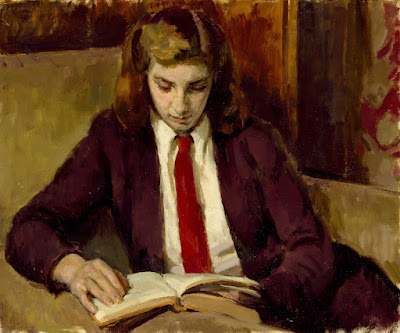 |
| Henry Lamb Henrietta Reading 1949 oil on canvas (diploma work) Royal Academy of Arts, London |
"This is a portrait of the artist's 17-year-old daughter, made as she was about to begin her studies at Somerville College, Oxford. Henrietta was the eldest child of Henry Lamb and the writer Lady Pansy Pakenham. She grew up in an artistic household, the family home near Salisbury playing host to her mother's literary circle that included Evelyn Waugh and John Betjeman. From a young age Henrietta developed such a passion for reading that even her family commented on her tendency to disappear for hours on end to read anything she could get her hands on. After studying at Oxford, Henrietta worked briefly for the magazine History Today before becoming a landscape gardener, beginning a long career working for Kensington and Chelsea borough council."
 |
| Donald McMorran Design for Estate Cottages, West Wycombe, Buckinghamshire 1950 drawing (diploma work) Royal Academy of Arts, London |
 |
| Christopher Sanders Study of Long Grass near Polstead ca. 1950 oil on panel (diploma work) Royal Academy of Arts, London |
– quoted texts adapted from Royal Academy notes







